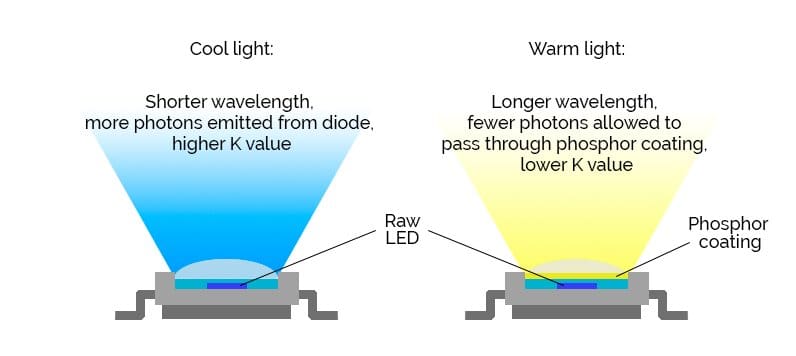
When it comes to lighting an environment where people congregate, whether at your home, or at a large international trade show, it’s important to consider how much of a role lighting and color temperature can play in the setting.
What's Color Temperature?
The color temperature of “white light” can be broken down into a range on the Kelvin temperature scale. Based approximately on the colors of radiated light from a black-body (ie: anything hot enough to emit visible light). In this scale anything above 5000K is considered to have a cool blueish color, while anything below 5000K would be considered to have a warm yellowish color. This can sometimes cause confusion as the warmer yellowish light is actually cooler from an infrared (physical sensation of heat) standpoint, and vice versa. Note that colors such as green, magenta, violet, etc. do not exist on the color temperature scale, as these wavelengths of light are measured and represented in nanometers. For an understanding of how accurate artificial light can be perceived relative to sunlight, take a look at the CRI or Color Rendering Index. Learn more about that here.

How Color Temperature is Created in LEDs
The diodes that emit light by default emit a cool blueish-white light (higher Kelvin value). To “warm up” the LED, various amounts of a phosphor coating are applied to the diode which yellows the emitted light to a warmer Kelvin value (typically 5,000K or below).

How to Decide When to Use Warm or Cool Light?
When should you pick one color temperature over another? If you are lighting an office space, front desk, computer lab, or laundry room for example, cooler color temperatures will be better suited for these areas. Bulbs in the 5000K+ range have more of a blue-white hue to them and are better for focus tasks or convey an alert or clean setting. However, you wouldn’t want to run these same cooler bulbs in the more relaxed setting of a restaurant, hotel room, lobby, or living room. For these areas, warmer bulbs in the 2000-3000K color temperatures would be preferred. Incorrect lighting can adversely affect the mood of individuals. The wrong color of light shining on a plate of food can change its appearance and make it look unappetizing. Similarly, after a tiring day of traveling, the wrong color temperature in front of a mirror can make you appear more worn-out than you really feel. In a nutshell, color temperature is setting dependent – and 100% subjective.


Click on blue circle to drag slider left and right.
Above: A living-room’s relaxed setting is better suited for warm soft light (left) vs cool white or daylight color (right)
Below: A garage or shop is better illuminated in cool color (right) for improved contrast and concentration in a working environment.


Ultimately choosing how to illuminate a space is 100% subjective. Lighting is one of those things that many people overlook, but you don’t have to be one of them! If you have any questions or would like us to help you make a choice based on your needs, please feel free to reach out to us. We’d be happy to help!

